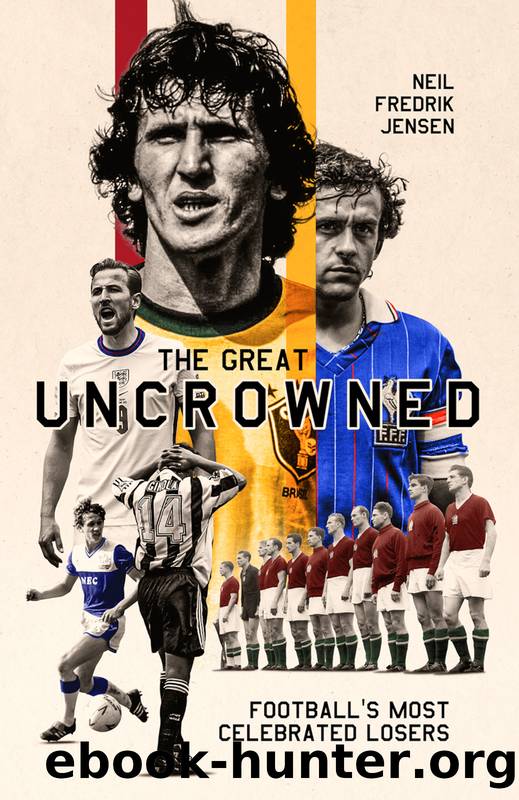The Great Uncrowned: Football Most Celebrated Losers by Neil Jensen;

Author:Neil Jensen;
Language: eng
Format: epub
Publisher: Mint Associates Ltd
Published: 2022-06-15T00:00:00+00:00
13
QPR 1976: Total football in the Bush
WEST LONDON belonged to Chelsea between the mid-1960s and early 1970s. Not only were they a vibrant team who could produce stunning football, but they were also trendy and capable of attracting celebrities, actors and even the odd member of the royal family. Chelsea made a lot of noise in that period, casting neighbours Fulham and Queens Park Rangers into the shadows.
QPR started to rise in the 1960s, though, winning promotion from the Third Division to the First Division in consecutive seasons, securing a place in the top flight for the first time in 1968. They also won the first League Cup Final at Wembley in 1967, beating West Bromwich Albion in dramatic style.
In 1967/68, the year that QPR reached the First Division for the first time in their history, Chelseaâs attendances at Stamford Bridge were around double their Loftus Road gates. Fulhamâs crowds were also bigger than QPRâs, at an average of 22,000 compared to Rangersâ 18,500. Chelsea enjoyed 35,000 crowds at their vast stadium.
QPRâs debut season in the First Division was a disaster, failing to win a game until October and ending with just four victories from 42. They went down with only 18 points, using three managers, including former Chelsea boss Tommy Docherty, who lasted for 29 days in the role before falling out with chairman Jim Gregory. The jump from third tier to the top had been too sudden and Rangers didnât have the resources to sustain First Division football.
While Fulham had Johnny Haynes and Chelsea had Peter Osgood, QPR had their own talisman in Rodney Marsh, who eventually left for Manchester City, earning his club a £200,000 fee. Marshâs replacement was, effectively, Stan Bowles, a richly talented player who lived the life of a ârock and rollâ footballer.
After relegation in 1969, Rangers spent four seasons trying to get back to the top. In west London the tide was turning; Chelsea declined significantly between 1971 and 1973, largely because of an expensive new stand, an economic downturn and growing unrest among the players in their relationship with management. There was another side to the story, however, and it forms part of the legend of the clubâs players of the time. There was a big drinking culture at Chelsea and it is not hard to link that to the declining performance of the team after their FA Cup and European Cup Winnersâ Cup successes of 1970 and 1971. As Chelseaâs star waned, QPRâs appeared to be in the ascendancy.
QPR appointed Gordon Jago as caretaker manager in January 1971, a highly respected football man who played for Charlton Athletic and briefly managed the United States national team. Jago replaced Les Allen and had a tough job to lift the mood at Loftus Road, where crowds had dropped to 11,000. Marsh was still at the club and was regaining his best form. QPR ended 1970/71 with just one defeat in ten games so Jago was given the job on a permanent basis.
It wasnât a one-man show, and Marsh wasnât the only player who caught the eye.
Download
This site does not store any files on its server. We only index and link to content provided by other sites. Please contact the content providers to delete copyright contents if any and email us, we'll remove relevant links or contents immediately.
Futebol by Alex Bellos(2129)
No Hunger In Paradise by Michael Calvin(1737)
Pep Confidential by Martí Perarnau(1687)
Cristiano Ronaldo: The Biography by Guillem Balague(1463)
Sir Matt Busby by Patrick Barclay(1459)
The Game of Our Lives by David Goldblatt(1440)
ALEX FERGUSON My Autobiography by Alex Ferguson(1434)
Cyrille Regis: My Story by Cyrille Regis(1418)
No Nonsense by Joey Barton(1405)
Football's Strangest Matches by Andrew Ward(1392)
Angels with Dirty Faces by Jonathan Wilson(1355)
The Lost Boys by Ed Hawkins(1336)
Red Card by Ken Bensinger(1304)
Soccer Men: Profiles of the Rogues, Geniuses, and Neurotics Who Dominate the World's Most Popular Sport by Simon Kuper(1202)
A Season With Verona by Tim Parks(1184)
We Are the Damned United by Phil Rostron(1158)
Scholes : My Story (9781471125799) by Scholes Paul(1156)
Forward: A Memoir by Abby Wambach(1147)
50 Complete Goalkeeping Training Sessions by Hageage Tamara Browder(1143)
